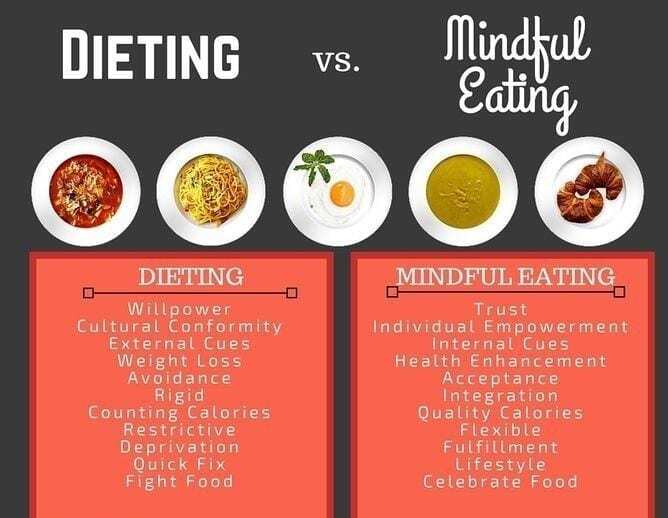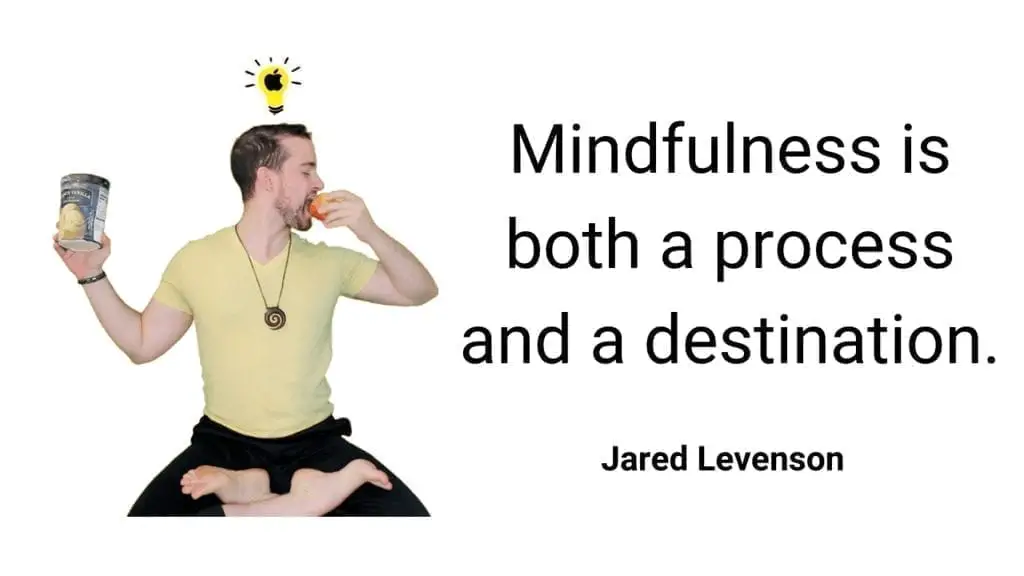Slow down there tiger, don’t chow down your meal so fast this is not the wild jungle!
Mindful eating requires you to actually taste your food, and slow down enough to feel your body and think “Do I even like what I’m eating right now?”
(Don’t worry – you don’t have to spend 5 minutes per bite)
This Mindful Eating 101 article will cover the following topics:
- What Is Mindful Eating?
- Mindful Eating Exercise
- Mindful Eating Benefits
- Tips to Mindful Eating
What is Mindful Eating? A Realistic Look In Today’s Society
Hopefully this true story about my distracted eating this morning, along with my personal definition of mindful eating in the next section, gives you a top-level, big picture.
Let’s begin in my kitchen this morning …
If you’re like me, you spend more time thinking about food, or thinking about something else while you eat food, instead of actually being present for food. Just this morning I caught myself listening to Joe Rogan talk about the coronavirus while I mindlessly stuffed food into my mouth.
Then I face palmed myself. “Jared! You’re about to be writing about mindful eating, you’d better actually practice it yourself!“
A few hours went by. I let my self-criticism go and noticed I was hungry. Time to eat. I went downstairs, prepared a meal, sat down, and began eating again. But I had forgotten my phone!
I felt slightly anxious about not having my phone on me, so I left my meal and then came back down with my phone. It’s crazy how attached we are to our phones myself included! I was just putting my phone on the table about to turn on Joe Rogan again …
When I remembered something – I remembered that I wanted to practice mindful eating.
- I looked out the window. Sunlight poured in through the open window.
- Saw a bird fly outside.
- Poked my food with my fork.
- I stared at my food, noticed the yellow yolk of the eggs.
- Took a bite. A pretty normal bite. Nothing special
- Turned on Joe Rogan and ate the rest of my meal semi-distracted and pretty quickly
Personal Example Video
How I Approach Mindful Eating (And How It Relates To Mindfulness In General)
Now as you can tell in this story, I’m NOT:
- spending inordinate amounts of time chewing
- putting my phone away for the whole meal
- levitating while changing om and making food hover into my mouth
So what is mindful eating? Let’s first look at an ideal list of what mindful eating includes. But don’t get scared away or overwhelmed by this! It’s just an ideal. You don’t need to try for this ideal, especially when you are beginning. Instead, below I’ll give you an imperfect but more realistic, more casual approach to mindful eating.
As a lofty ideal, mindful eating includes:
- chewing slowly and without distraction
- attuning to cues like hunger and fullness
- knowing the what hungers feels like versus emotional triggers for overeating
- noticing taste, colors, sounds, textures, etc
- making your food morally neutral, or practicing non-judgment
Like I said, this is the lofty ideal. But it’s scary and in this way because many people feel overwhelmed at THIS the idea of mindful eating. For example, they Many people think to themselves:
- I have to eat my food without distractions? Oh no, I can’t do that
- I have to be present while I eat? Good luck I know myself and my mind wanders when I eat
- I can’t eat fast? Hell no!
But rather than worry about this “ideal”, let’s be more realistic. Mindful eating to me is pretty simple:
- I take a few moments to see how I’m feeling
- I notice if I’m even hungry
- Taste a few bites of food
- Don’t set too high standards
- Don’t spend too much time
Now this is just my personal approach, but I wanted to address this question of “What is Mindful Eating?” in this way to help you to not feel overwhelmed.
Ok so you get the point. Mindful eating can be casual, and that’s how I recommend you starting out. Down below I’ll talk about some of the benefits of mindful eating …
But also, for those of you who are interested in how this fits with some broader conceptual frameworks, first let’s see how the ideal and the casual approach to mindful eating fits in with the general topic of get the technical, scientific definition of Mindfulness.
The word ‘mindfulness’ was first spoken about by The Budda, but the scientific definition of mindfulness that was defined by Jon Kabat-Zinn ais “paying attention in a particular way, on purpose, in the present moment, and nonjudgmentally”
Joe Rogan “How To Practice Mindfulness”
The first few minutes cover the essentials steps spoken from a very practical perspective.
In the video these guys discuss mindfulness – but most importantly – these guys are skeptics! They don’t believe in any practical nonsense. They only believe in hard, empirical science.
And these science guys are saying…
- Your mind is going to wander and you’ll think you’re crazy
- You’ll get bored
- And all you have to do is bring your mind back to your breath
- Again and again
- That’s it
The Famous Raisin Mindful Eating Exercise
The scientist Jon Kabat-Zinn has become pretty well known for his Mindful Eating Exercise. Even Miller Lite loving Congress men like Tim Ryan are starting to embrace chewing grapes and raisins with mindful eating!
The following steps for this exercise come from Jon’s Mindfulness Based Stress Reduction website. These steps are comprehensive and will take you a few minutes to get through.
Please note that you do not have to go through all these steps every meal to be successful at Mindful Eating!!!
If you’d like to listen to a guided MP3 of mindful eating, you can download one on my website or go to the Mindfulness Based Stress Reduction website.
- Put a couple of raisins on your palm. Don’t worry if you don’t have raisins. You can pick a few chocolate squares, or nuts.
- Look at the food with a beginner’s mind.
- Begin to discover the food in a new way using all your senses …
- With your eyes, scan this piece of food that you have never seen before. Look at all the colors, the little tiny details, curve, corners and shades.
- With your fingers, turn around the piece of food and feel it. Rub your finger pads over the food. Notice the folds. Notice the textures. If your food is salty or comes off in your fingers – like crackers or chocolate – notice the residue on your fingers. Is it soft? Coarse? Warm? Cold?
- Wave the food under your nostril and try to smell. I have notoriously bad smelling so I can’t smell much but even I can smell most foods if I hold the food item right under my nostrils and take a good whiff.
- Any sounds? Probably not, but you never know 🙂
- Then bring the food up to your lips and pause! Don’t eat the food just yet. Notice how your arm muscles coordinate automatically to lift the food up to your lips. Are you salivating yet with that raisin or chocolate an inch from your mouth?
- Gently put the piece of food on your tongue and don’t swallow yet. Just let your tongue now connect with the physical feeling of this object. Whew … it’s hard not to swallow right?!
- Finally, bite down on the object. Once you start chewing just be aware of how your mouth muscles automatically know how to chew the food, move the food side to side – and miraculously you never bite your tongue!
- Become aware of the saliva as you chew slowly…
- Intentionally decide to swallow the food. Again, notice the sensations of the food running down your throat.
- Take a moment after you are all done to reflect.
Did you notice the sensations, as well as the intentions in this exercise? The sensations of before and during? The intentions to notice your body before, pause right before eating, to purposefully bite down, and to purposefully swallow?
This mindfulness exercise is why mindfulness is one of the best tips to stop food cravings!
What Are The Benefits Of Mindful Eating?
The number one benefit of mindful eating is slowing down. When you eat really quick your stomach doesn’t think you are full and you keep eating.
Scientists say it takes 20 minutes for your stomach to register that you are full.
When you bring a bit of mindfulness, you slow down. When you slow down, you make eating purposeful instead of mindless. You can then gradually learn as you practice mindful eating to not eat as much.
This benefit of slowing has many ripple effects:
- decrease the amount of distracted eating – when you are distracted you can eat way more food without even knowing it
- instead of automatically placing the next bite of food in your mouth you can restore body awareness and notice if you are actually hungry
- by making a commitment to mindful eating you will notice when you do NOT eat mindfully. And when s you notice that when you DON’T eat mindfully, then you can begin to notice why.
- As you notice why you don’t eat mindfully, over time you will build up a data bank of triggers. These are emotions, people and situations that cause you to overeat automatically!
- As you study your eating habits and eating behaviors, you can notice what triggers cause you to mindlessly overeat!
- Finally with greater awareness of triggers, you can begin to avoid these situations in the first place. You notice that lack of sleep leads to triggers, that not eating leads to triggers, etc. Awareness of your triggers leads you to change your very deep rooted eating habits.

Does Mindful Eating Work?
Here’s my clients thoughts on whether mindful eating works …
And here’s my frank opinion on whether mindful eating works.
Yes, mindful eating – eating while paying careful attention does work. How could it not?
This isn’t a trick. This isn’t some nutrition product like Nutella that’s being marketed as being a healthy thing but then turns out is full of sugar. Or, “fat free” products that have no fat but loads of sugar. Companies do these sorts of tricks all the time.
You should be suspicious of any new eating behavior or idea, whether it’s just a new fad or whether it can really change your life.
But relax, mindful eating works because it’s just pausing, slowing down. It’s just awareness. And there is tremendous power to awareness. No gimmicks. It’s just being aware.
But my main point about whether mindful eating works is that mindful eating is just one piece of the puzzle.
No – this whole paying-attention-while-you-eat-practice magically make you stop binge eating. Binge eating is a complex phenomena.
And part of the puzzle is that it helps to combine mindful eating with something else. For example, when I first learned mindful eating while on a meditation retreat in a mountainous wilderness, we were mindfully eating and in a totally different environment.
Another example – Mindful Eating is taught in the context of the Mindfulness Based Stress Reduction courses that I described above.
Now, I need to end with a cautionary note, because some people may think that mindful eating by itself can also help you solve serious problems such as binge-eating. It’s important to understand that this is not the caseNo – this whole paying-attention-while-you-eat-practice cannot magically make you stop binge eating. Binge eating is a complex phenomena, and while m.
Mindfulness is part of the process to stop binge eating, but it’s not the entire solution. It can also help, but again is not the entire solution, in In terms of treatment for:
No – this whole paying-attention-while-you-eat-practice magically make you stop binge eating. Binge eating is a complex phenomena.
Mindfulness is part of the process to stop binge eating, but it’s not the entire solution. In terms of treatment for:
- binge eating disorder
- stress eating
- emotional eating
- compulsive eating
- food addiction







